Part 2. What Tracks Are These?
© Bruce G. MarcotLet's switch gears. And in so doing, I will reveal my own interpretation of these mystical tracks.
What walked here? is a common question asked by any field-going wildlife biologist or naturalist. I will narrow that question to a set of animals whose tracks are just big enough, just humanoid-like enough, and variable enough to solicit some possible confusion among non-experts.
And those animals are simply enough the species of the family Ursidae, or bears.
Let's take a look at some bear tracks. Specifically, let's first look at a set of drawings -- all done by professional wildlife biologists in published science books -- of one aspect of bear tracks. That is, that bears, of different species in different parts of the world, commonly overstep their own tracks, or step in the same tracks made by other individual bears or by themselves.
American black bears (Ursus americanus) do this. Here is
a drawing of some tracks of a female American black bear, from Olaus J.
Murie's "A Field Guide to Animal Tracks" (see Citations below):
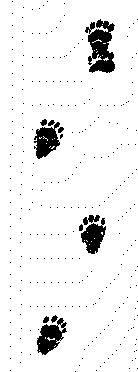
Each of the 4 tracks shown here consists of two overlapping tracks
-- the track of the longer hind foot overstepping and partially obscuring that of the shorter front foot. American black bears do not always
do this, but they do it often enough so that field biologists need to know
to watch for this pattern.
I have seen this myself many times. Here are three photos I took
in the Klamath Mountains of northwestern California, of American black
bear tracks showing this overstepping pattern:
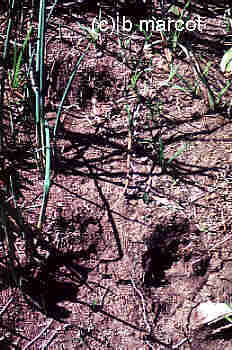
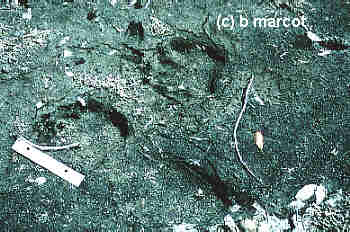
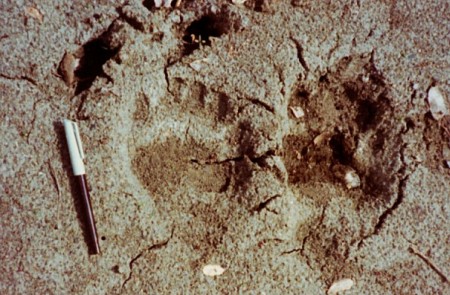
![]()
I took the above photos along the wet mud shoreline of inland ponds, on Six Rivers National Forest, in mixed conifer-hardwood forests of Douglas-fir. The first photo does show that the bear stepped with its hind feet into the tracks of the front feet. The second photo doesn't quite show this overstepping, but on the left pair the shorter front foot (with a 6-inch ruler next to it) is trailed by the longer hind foot. If the hind foot came up just a bit further, it would appear as one long intermingled print. The right print is clearly just the front foot alone. The third photo shows the overstepping pattern and could be interpreted as made by a much larger foot. Only when I inspected other prints in the same track sequence did it become clear that this was made by a black bear stepping in its own tracks -- hind foot over the front foot print -- in soft mud, as they often do.
And other bear species do this too.
In the Far East of Asia (and elsewhere) roams the huge brown bear (Ursus
arctos), one form of which is the grizzly bear of North America.
A Russian field wildlife biologist by the name of Dimitri Pikunov has documented
the same kind of overstepping pattern in brown bears of the Russian Far
East, and has produced the following diagrams (from Oshmarin and Pikunov
1990) taken from actual tracks he observed in the field:


I have also encountered tracks of Himalayan black bears (Ursus or Selenarctos thibetanus) in the Himalayas of India and in the Russian Far East. Keep in mind that this species also ranges into the Garo Hills of Meghalaya in India, where we discovered that legend of Forest Man or Matdngdng. Here are some photos I took of their tracks (called "pugmarks" in India and elsewhere) along the upper Bikin River in Primorski Krai, Russian Far East:
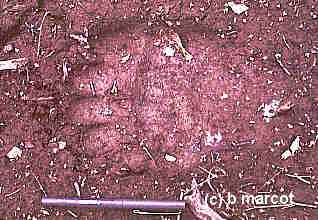
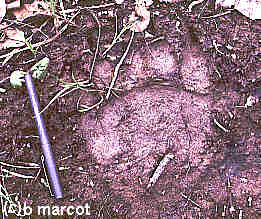
Himalayan black bears, too, can overstep their tracks, as shown in the following photo I took in Khedrovaya Pad Zapovednik (reserve) in Primorski Krai, Russian Far East:
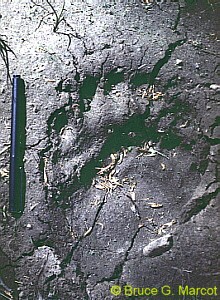
The pen in these photos is there for scale, and is 6 inches long.
Remember these photos, as we'll use them in our next section.
* * * *
I might mention here that, after I wrote the above passages, I found a very similar idea in a book by Nicholas Saunders (1995) called Animal Spirits. On tracks of the Yeti and Bigfoot, Saunders wrote:
"...the photographic evidence is not conclusive as very large footprints are sometimes produced by mountain bears. When travelling at a lope, bears place their hind feet partly over the imprints of the fore feet to produce tracks which look as if they were made by a large bipedal animal." (p. 144)
So the plot now thickens. Travel next to:
Part 3. So Who Made These, After All?
------------------------
AN ADDENDUM:
While I was recently in India, I discussed the tracks of Yeti with some
of the wildlife researchers of the Wildlife Institute of India in Dehra
Dun in the Himalayan foothills of Uttar Pradesh state. They noted
that when Himalayan brown bear traverses down slope in snow it often slides
its feet and steps in its own tracks or oversteps its own tracks, creating
huge, bipedal-appearing "pugmarks." While this is not proof that
the Yeti does not exist, it is a caution to interpret any such indirect
evidence very carefully...
CITATIONS
Murie, Olaus J. 1975. A field guide to animal tracks. Second edition. Houghton Mifflin Co., Boston MA. [Fig. 8, p. 26]
Oshmarin, P. G., and D. G. Pikunov. 1990. Tracks in nature. Science Academy CCCP, Moscow, Russia (Soviet Union). In Russian. [Plate 36, p. 91]
Saunders, Nicholas J. 1995. Animal spirits. MacMillan, London. 184 pp.